Genre: Shmup Developer: ZPF Team Publisher: Mega Cat Studios Players: 1 Released: 2025
A year ago, we previewed ZPF just before publisher Mega Cat Studios launched a Kickstarter to fund the game’s completion. There was a huge amount of potential in the preview build we played, and ZPF looked to be a solid release upon completion. Now, it’s finally here, and though there are a few wrinkles in its design, the final product is an excellent shmup that’s going to keep you glued to your Genesis console for quite some time.
ZPF isn’t really attempting to reinvent the shooter genre as much as it tries to bring most of the genre’s best elements to a single game. Molded from the same clay as Technosoft’s classics, Mega Cat Studios channels those titles with its high-speed gameplay and huge bosses, but it spices up the formula with shopping elements and a ton of secrets designed to keep players coming back after they’ve beaten the game a few times (which is no simple feat itself),
Developed by a passionate team of three – Gryzor Rozyrg, Mikael Tillander (who made Tanzer), and jgvex.eth – ZPF is a graphically-stunning shmup that started development in 2020. Having completed a successful Kickstarter campaign, ZPF is now ready to ship as a physical version with plastic clamshell box and full-color manual. If you’ve purchased other Mega Cat Studios titles like Sacred Line or Rocket Panda, then you know of the quality of their physical releases.
The game itself is a frenetic experience, with rich, detailed graphics and a booming soundtrack. There are seven total stages, the first three of which can be played in any order. The rest of the game is then played in a linear fashion. Players choose from three different playable ships – Gold, Gradius, and Knight – each offering its own play style. Knight seems to have the best melee attacks, while Gold has the strongest main weapon. Gradius has a weaker main attack but can attain a large number of projectiles to form a shield. The game is beatable with any ship, but it’s cool to have options. For instance, I’m not much for melee attacks in shmups, but a fully powered-up Gold can be devastating to use.
Achieving that level of power takes style and efficiency. Rather than just scatter power-ups at you during gameplay, ZPF gives players a chance to exercise a bit of strategy with its scoring system. The ship’s abilities are enhanced by earning money from vanquished enemies to upgrade their guns, much like Capcom’s Forgotten Worlds. Much like that game’s zenny, medals are currency collected from defeated enemies to cash in for points or to use between stages for upgrading different attacks, adding continues, or even reducing the damage of enemy fire. Depending on the ship you chose, the power-ups needed will change, and dying reduces the amount of medals you hold, thereby affecting your purchasing power. These mechanics add up to a complex and interesting experience with good replay value because multiple playthroughs are required to learn the ins and outs of each ship’s capabilities. ZPF further builds on the replay premise by also including different endings that depend on the character used, route taken, and score. For those who want a real challenge, each stage has a hidden key that needs to be collected (along with some other unknown criteria) to see the game’s best ending.
ZPF Team didn’t just rush the game out since releasing a demo last year. It was already quite polished then, but the gameplay does seem a bit tighter in the final build. Control is fast and responsive, with three buttons used – melee attack, main weapon, and bomb – a scheme shmup fans will instantly and intuitively dive into. It all comes snuggled nicely within excellent presentation, including a scorching soundtrack and crisp, detailed stages with lots of variety in the stage design.
About those stages… As solid as everything is, there were a few things I hoped would be tweaked for the final release. Unfortunately, they weren’t. First, the way the game transitions between areas during play is a bit jarring. They move to different backgrounds several times over the course of a stage, but there doesn’t seem to be a reason for the change. It’s almost as if the developers designed a ton of stages but couldn’t fit them all, so they decided to at least include pieces of each. I’m reminded of the contrast presented by shmups like Gaiares that have transitions to different areas, but they’re done gradually as a continuation of the current stage, and it’s much more natural. Also, the way the backgrounds scroll is kind of odd. Several stages have multiple layers that move in different directions rather than each moving in the same direction at different speeds. It kind of ruins the sense of depth that parallax is supposed to convey. Sure, this isn’t a major issue, but it’s one that kind of irked me because I love parallax scrolling in old school games.
These complaints are minor, but my biggest issue actually concerns gameplay. The backgrounds in ZPF are spectacular, but your ship often gets lost in them. Too many of my game deaths came from not being able to see my ship among a hail of enemy fire. In all fairness, it doesn’t happen enough to ruin the game, but it can be frustrating to lose a powered-up ship because it disappeared into the background. Let me put things in perspective, though. My gripes are mostly cosmetic, and ZPF isn’t the only shmup to have background issues.
None of these concerns should be enough to put you off from playing what is one of the better Genesis shmups released and the best aftermarket one to appear thus far. There is no reason for any fan of the genre to pass it up. ZPF Team has mixed an adrenaline-fueling cocktail of twitchy action, great visuals, and an amazing soundtrack to make your Genesis sing once more. I commend them for a remarkable first effort that will hopefully mark the start of a franchise.
Do you own a Genesis? Are you a shmup fan? Then you know what you must do.
SCORE: 8 out of 10

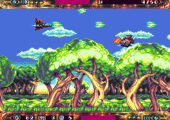
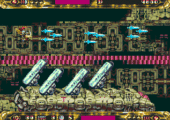
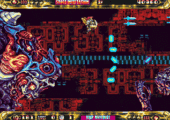
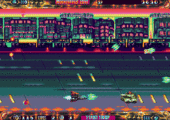
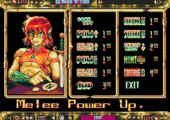
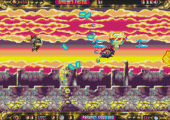
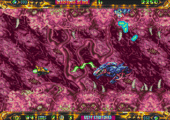
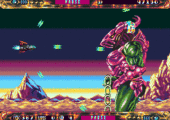
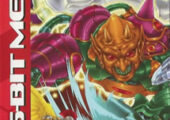
Recent Comments